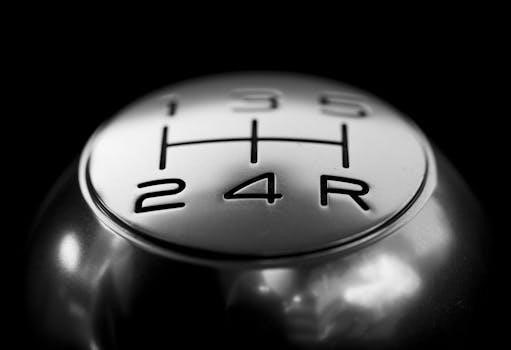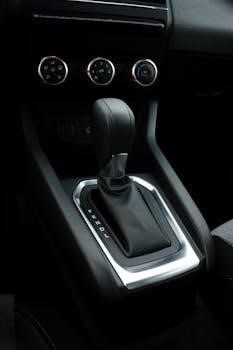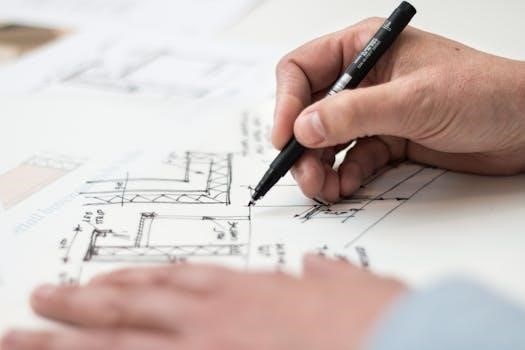Sequential Gearbox Manual⁚ A Comprehensive Guide
This guide delves into the world of sequential gearboxes‚ exploring their function and operation․ We will cover the advantages they offer over traditional manual transmissions․ Finally‚ we will discuss their common applications in racing cars and motorcycles and some higher-end cars․
What is a Sequential Gearbox?
A sequential gearbox‚ also known as a sequential manual transmission (SMT)‚ represents a distinct type of transmission mechanism primarily found in motorcycles and racing cars․ Unlike the traditional H-pattern manual transmission‚ a sequential gearbox restricts gear selection to a sequential order‚ meaning drivers can only shift up or down to the next adjacent gear․
This design eliminates the need for complex gear selection patterns‚ simplifying the shifting process․ In essence‚ instead of navigating through an H-pattern‚ the driver simply pushes or pulls a lever to move to the next gear in the sequence․ This sequential shifting mechanism contributes to faster and more efficient gear changes‚ particularly advantageous in racing environments where split-second decisions are critical․
While often associated with racing and motorcycles‚ sequential gearboxes are also finding their way into some high-performance cars․ Their design features ensure sequential gear availability and often utilize dog boxes instead of torque-operated synchronizers․ This contributes to the overall speed and efficiency of gear changes‚ making them a preferred choice for performance-oriented applications․
Sequential vs․ Manual Transmission⁚ Key Differences
The core difference between a sequential and a traditional manual transmission lies in the gear selection process․ A manual transmission typically employs an H-pattern shift layout‚ requiring the driver to move the gear lever through a specific pattern to engage different gears․ This necessitates a degree of dexterity and can be slower‚ especially during rapid gear changes․
In contrast‚ a sequential gearbox restricts gear changes to a strict sequence․ The driver simply pushes or pulls a lever to shift up or down to the next gear in the sequence․ This eliminates the need for navigating a complex pattern and results in significantly faster shift times․
Another key difference is the level of mechanical complexity․ Manual transmissions often use synchronized gears‚ which require more intricate mechanisms to ensure smooth engagement․ Sequential gearboxes frequently utilize dog clutches‚ which are simpler and more robust but can result in harsher shifts if not properly managed․ Finally‚ sequential transmissions are the leading choice for race car constructors․
How a Sequential Gearbox Works⁚ The Operating Principle
The operating principle of a sequential gearbox revolves around its ability to shift gears in a direct‚ consecutive manner․ Unlike a manual transmission with its H-pattern‚ a sequential gearbox uses a ratcheting mechanism to engage and disengage gears in a specific order․ This mechanism is typically controlled by a shift lever or paddle shifters․
When the driver initiates a shift‚ the ratcheting mechanism rotates a selector drum․ This drum has grooves or channels that correspond to different gear positions․ As the drum rotates‚ it moves selector forks‚ which in turn engage or disengage the appropriate gears․ The design ensures that only one gear can be engaged at a time‚ preventing accidental selection of multiple gears․
Some sequential gearboxes utilize hydraulic or pneumatic actuators to move the selector forks‚ allowing for faster and more precise shifts․ Electronic control units (ECUs) can also be integrated to manage the shifting process‚ optimizing shift timing and smoothness․ This function is via a small switch mounted into the paddle assembly․
Benefits of Using a Sequential Gearbox
Sequential gearboxes offer several key advantages over traditional manual transmissions‚ particularly in performance-oriented applications․ One of the primary benefits is faster shift times․ The sequential nature of the gear selection process‚ where gears are shifted one after another‚ allows for quicker transitions between gears compared to the H-pattern shifting in a manual gearbox․ This results in improved acceleration and overall performance․
Another advantage is the reduced risk of mis-shifts․ With a sequential gearbox‚ the driver only needs to push or pull the shift lever to engage the next gear‚ eliminating the possibility of accidentally selecting the wrong gear․ This is especially crucial in racing situations where precise gear selection is essential․
Furthermore‚ sequential gearboxes often provide a more direct and engaging driving experience․ The positive and tactile feedback from each gear change gives the driver a greater sense of control and connection with the vehicle․ The sequential gearbox provides became widespread in the mid-1990s․ Overall‚ the benefits of faster shift times‚ reduced mis-shifts‚ and enhanced driving experience make sequential gearboxes a popular choice in motorsports and performance vehicles․

Applications of Sequential Gearboxes⁚ Where Are They Used?
Sequential gearboxes find their primary applications in environments where rapid and precise gear changes are crucial․ They are most commonly found in motorcycles‚ where the sequential shift pattern allows riders to maintain better control and focus on steering and balance․ The quick and direct gear changes are particularly advantageous in racing scenarios․

Racing cars‚ especially those in Formula 1‚ rally racing‚ and other high-performance motorsports‚ also heavily rely on sequential gearboxes․ The reduced shift times and lower risk of mis-shifts provide a competitive edge‚ allowing drivers to maximize acceleration and maintain optimal engine performance throughout a race․ Furthermore‚ some high-end sports cars and performance vehicles incorporate sequential gearboxes to deliver a more engaging and dynamic driving experience․
Beyond motorsports‚ sequential gearboxes are also used in certain industrial applications where precise and rapid gear changes are necessary․ These may include specialized machinery and equipment where efficiency and control are paramount․ Overall‚ the applications of sequential gearboxes are concentrated in areas that demand high performance‚ precise control‚ and rapid gear transitions․
Manual Operation of a Sequential Gearbox
The manual operation of a sequential gearbox differs significantly from that of a traditional H-pattern manual transmission․ Instead of navigating through a complex pattern to select gears‚ the driver simply pushes or pulls a lever to shift up or down sequentially․ This simplified process allows for faster and more intuitive gear changes‚ reducing the risk of errors during high-performance driving․
To upshift‚ the driver typically pushes the lever forward or pulls it back (depending on the specific design)․ To downshift‚ the opposite action is performed․ Each movement corresponds to a single gear change‚ ensuring a direct and predictable response․ In many sequential gearboxes‚ a clutch is required only for starting from a standstill; subsequent gear changes can often be performed without using the clutch‚ further accelerating the shifting process․
The sequential nature of the gearbox means that the driver can only shift to the next adjacent gear‚ either up or down․ There is no possibility of skipping gears or directly selecting a non-adjacent gear‚ as is possible with an H-pattern gearbox․ This limitation‚ however‚ contributes to the gearbox’s simplicity and speed‚ making it ideal for racing and other performance-oriented applications․
Shifting Mechanism⁚ Lever and Solenoid Control
The shifting mechanism in a sequential gearbox relies on a combination of mechanical and electronic components to achieve rapid and precise gear changes․ The driver initiates a gear change by manipulating a lever‚ which is typically located near the steering wheel for easy access․ This lever is connected to a series of linkages or a solid rod that transmits the driver’s input to the gearbox․
In many modern sequential gearboxes‚ solenoids play a crucial role in actuating the gear shifts․ When the driver moves the lever‚ an electrical signal is sent to the gearbox control unit (ECU)․ The ECU then activates specific solenoids‚ which control hydraulic or pneumatic actuators․ These actuators precisely engage or disengage the gears within the gearbox‚ resulting in a swift and seamless gear change․
The use of solenoids allows for a high degree of control and customization․ The ECU can be programmed to optimize shift times and smoothness based on various factors‚ such as engine speed‚ throttle position‚ and vehicle speed․ This electronic control also enables the implementation of features like automatic downshifting and launch control‚ further enhancing the performance and usability of the sequential gearbox;
Clutch Usage in Sequential Gearboxes
Clutch usage in sequential gearboxes differs significantly from traditional manual transmissions․ While a clutch is typically required to initiate movement from a standstill‚ its role during subsequent gear changes is often minimized or even eliminated in high-performance applications․ This difference stems from the design and operation of sequential gearboxes‚ which prioritize rapid and seamless shifts․
In many sequential gearbox systems‚ especially those found in racing cars‚ the clutch is primarily used for launching the vehicle from a stationary position․ Once the vehicle is in motion‚ gear changes can be executed without depressing the clutch pedal․ This is achieved through the use of dog rings‚ which engage and disengage the gears with minimal interruption to power delivery․ Electronic control units manage engine rev-matching during shifts‚ ensuring smooth transitions and preventing driveline shock․
However‚ some sequential gearbox systems‚ particularly those in motorcycles or road-going vehicles‚ may still require clutch engagement for upshifts and downshifts‚ albeit with a lighter touch than in traditional manuals․ In these cases‚ the clutch serves to momentarily unload the transmission‚ facilitating smoother gear engagement․ The specific clutch usage protocol varies depending on the gearbox design and the manufacturer’s recommendations․
Sequential Gearbox and Rolling on a Slope
A vehicle equipped with a sequential gearbox‚ much like one with a traditional manual gearbox‚ possesses the inherent characteristic of being susceptible to rolling on a slope․ This vulnerability arises from the mechanical connection between the engine and the wheels when a gear is engaged‚ particularly when the vehicle is stationary on an incline or decline․ Unless preventive measures are taken‚ gravity’s influence can cause the vehicle to move․
The absence of a torque converter‚ which is typically found in automatic transmissions‚ means that there is no inherent mechanism to prevent the vehicle from rolling when a gear is selected․ Consequently‚ drivers must employ alternative methods to secure the vehicle on a slope․ The most common and reliable method is the application of the handbrake‚ also known as the parking brake․ This mechanical brake directly acts on the wheels‚ preventing them from rotating and thus preventing the vehicle from rolling․

Alternatively‚ the driver can continuously depress the brake pedal to achieve the same effect․ However‚ this method requires constant driver input and can be fatiguing over extended periods․ It’s crucial to remember that relying solely on engine braking or leaving the vehicle in gear is not a substitute for the handbrake or brake pedal‚ as these methods may not provide sufficient holding force‚ especially on steeper slopes․
Sequential Gearbox⁚ The Standard Option
The standard configuration for sequential gearboxes typically involves a lever-operated system‚ providing drivers with a tactile and intuitive method for gear changes․ In this setup‚ the driver executes an upshift by pulling the lever rearward‚ initiating a transition to the next higher gear in the sequence․ Conversely‚ a downshift is achieved by pushing the lever forward‚ engaging the next lower gear․
This ‘pull for upshift‚ push for downshift’ arrangement has become widely adopted due to its simplicity and effectiveness‚ particularly in racing applications where rapid and precise gear changes are paramount․ The lever system enables direct mechanical linkage‚ often employing a solid rod or linkage mechanism‚ which translates the driver’s input into immediate action within the gearbox․
Proper installation of the lever system is essential to ensure smooth and reliable gear changes․ Calibration is also important in this system․ This is what allows the system to work normally via a solid rod․ Fine-tuning the lever’s throw and sensitivity can optimize the overall driving experience‚ allowing for seamless transitions between gears․ While other actuation methods exist‚ such as paddle shifters with electronic control‚ the lever-based system remains a favored choice․

Sequential Gearbox⁚ Faster Shift Times
One of the primary advantages of a sequential gearbox is its ability to deliver significantly faster shift times compared to traditional manual transmissions; This improvement stems from the gearbox’s design‚ which enforces a strict sequential order of gear changes․ Unlike a manual transmission‚ where the driver must navigate an H-pattern to select gears‚ a sequential gearbox only allows upshifts or downshifts to the next adjacent gear․
The sequential nature eliminates the need for complex lever movements‚ reducing the time required to engage the next gear․ For example‚ shifting from second to third gear in a manual transmission involves moving the lever up‚ over‚ and up again‚ which consumes valuable time․ In contrast‚ a sequential gearbox achieves the same shift with a single push or pull of the lever․
This streamlined process translates into quicker acceleration and improved lap times‚ especially in racing scenarios where every fraction of a second counts․ Faster shift times contribute to maintaining momentum and minimizing power loss during gear changes․ The enhanced shift speed is a key factor․
Sequential Gearbox⁚ Uncomplicated Mechanism
The design of a sequential gearbox focuses on simplicity‚ resulting in a less complicated mechanism compared to traditional H-pattern manual transmissions․ In a standard manual gearbox‚ achieving precise gear selection requires significant dexterity and coordination from the driver․ The H-pattern necessitates navigating a complex shift pattern‚ increasing the potential for errors‚ particularly during high-pressure situations․
Sequential gearboxes streamline this process by using a straightforward mechanism that allows only sequential upshifts or downshifts․ This simplified design eliminates the need for intricate linkages and complex movements‚ resulting in a more robust and reliable system․ The absence of the H-pattern reduces the number of moving parts and decreases the chances of mechanical failure․
The uncomplicated nature of the sequential gearbox also contributes to its ease of use‚ allowing drivers to focus on other aspects of driving‚ such as maintaining optimal racing lines and braking points․ The reduced complexity makes the gearbox more forgiving‚ allowing for quicker adaptation․
Furthermore‚ the simplicity of the design is a contributing factor․
Sequential Gearbox⁚ Gear Availability
A key characteristic of sequential gearboxes is their strict adherence to sequential gear selection․ Unlike traditional manual transmissions where drivers can skip gears‚ a sequential gearbox mandates shifting through each gear in order‚ either up or down․ This means a driver cannot directly shift from second gear to fourth gear; they must pass through third gear first․
This sequential nature ensures a predictable and consistent shifting experience․ By limiting gear selection to the next adjacent gear‚ the gearbox simplifies the shifting process‚ making it faster and more intuitive․ This restriction‚ however‚ also means that the driver must anticipate upcoming gear changes and plan accordingly․
While the sequential nature might seem limiting‚ it is a deliberate design choice that enhances shift speed and reduces the risk of mis-shifts․ In racing environments‚ where split-second decisions are crucial‚ the predictability of gear availability outweighs the flexibility of skipping gears․ The driver can confidently execute gear changes without the need to search for the correct gear position‚ enabling them to maintain focus on the track․
Furthermore‚ this system can be easily managed using solenoids․

No Responses